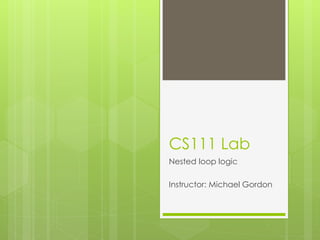Denunciar
Compartir
Descargar para leer sin conexión

Recomendados
Más contenido relacionado
La actualidad más candente
La actualidad más candente (20)
Destacado
Destacado (9)
Similar a Shape logic 1
We have established a new general method to build doubly even magic squares. New types of magic squares are built. The method is aesthetic and easy to understand and has remarkable topological properties.Arithmetic Progressions and the Construction of Doubly Even Magic Squares and...

Arithmetic Progressions and the Construction of Doubly Even Magic Squares and...Lossian Barbosa Bacelar Miranda
Similar a Shape logic 1 (20)
Delaunay triangulation from 2-d delaunay to 3-d delaunay

Delaunay triangulation from 2-d delaunay to 3-d delaunay
The Ring programming language version 1.9 book - Part 30 of 210

The Ring programming language version 1.9 book - Part 30 of 210
The Ring programming language version 1.8 book - Part 28 of 202

The Ring programming language version 1.8 book - Part 28 of 202
Arithmetic Progressions and the Construction of Doubly Even Magic Squares and...

Arithmetic Progressions and the Construction of Doubly Even Magic Squares and...
Más de Michael Gordon
Más de Michael Gordon (12)
Raspberry Pi presentation for Computer Architecture class

Raspberry Pi presentation for Computer Architecture class
Shape logic 1
- 1. CS111 Lab Nested loop logic Instructor: Michael Gordon
- 2. Conceptualize Think of your printing space as a grid with rows and columns 0 1 2 0 * * * * 1 * * * * 2 * * * 1 2 3 1 * * * 2 * * 3 * *
- 3. Simple right triangle Where does a star appear? 1,1; 2,1; 2,2; 3,1; 3,2; 3,3 In each row, the col # with a star starts at 1 and goes until the row #. The same logic applies for a larger grid. 1 2 1 * 2 * * 3 * 3 * 1 2 * 3 1 * 2 * * 3 * * * 4 * * * 4 *
- 4. Simple right triangle Rows go from 1 to n. On each row we output a star in each column until column equals row. for(int r=1; r<=n; r++){ for(int c=1;c<=r;c++){ cout<<“*”; } cout<<endl; }
- 5. Finding the middle You don’t know what input size the user will give, so how will you know where the middle is? If n=3, then the middle is 2 If n=5, then the middle is 3 1 2 3 middle = n/2+1 1 * 1 2 3 2 * 1 * 3 * 2 * 4 * 3 * 5 * 4 5
- 6. Isosceles Triangle The first thing you may notice 1 2 about this “triangle” is that it 1 doesn’t start at the top of the 2 * grid. For the sake of space 3 * * (and other considerations) let’s try to figure out (given the number of columns) how many rows we need. 3 *
- 7. Column-to-row ratio 3 columns: 2 rows 5 columns: 3 rows 7 columns: 4 rows (not shown) rows = columns/2 + 1 (same formula as finding the middle) 1 2 3 1 2 * 3 * 1 2 * 3 * 4 5 1 2 3 * 4 5 * * * * * * * *
- 8. Starting at Zero We often start our rows and columns at zero instead of one. In that case, the formula for the middle would be: mid = n/2 instead of n/2+1 At right: n = 3. 3/2=1 (int div) and 1 is the middle column. 1 2 1 * 2 * 3 3 * 0 1 0 * 1 * 2 * 2
- 9. Center+diagonals for (int r = 0; r <= rows; r++) { for (int c = 0; c <= cols; c++) { if (c==cntr+r || c==cntr-r || c==cntr) cout << "*"; else cout << " "; } 0 1 0 3 4 * 1 2 2 * * * * * *
- 10. Center+diagonals for (int r = 0; r <= rows; r++) { for (int c = 0; c <= cols; c++) { if (c>=cntr-r && c<=cntr+r) cout << "*"; else cout << " "; } cout<<endl; } 0 1 0 3 4 * 1 2 2 * * * * * * * *
